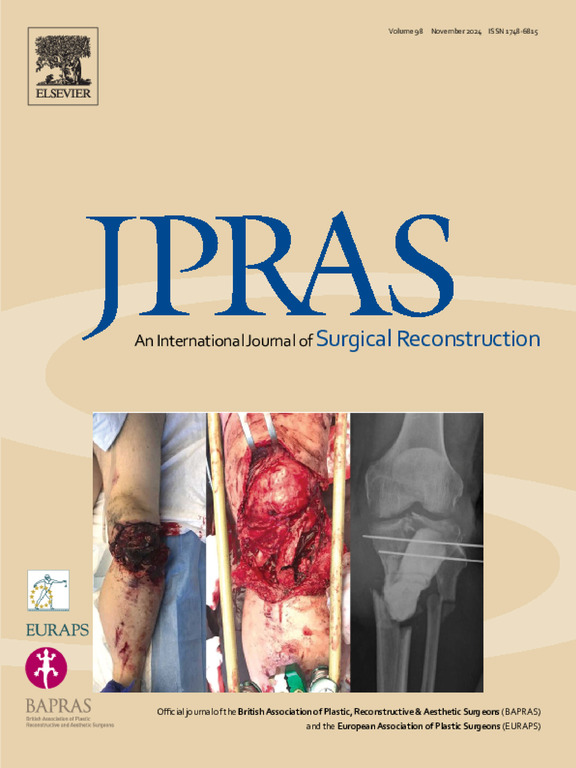整形外科中身体畸形障碍症状的流行研究。
IF 2
3区 医学
Q2 SURGERY
Journal of Plastic Reconstructive and Aesthetic Surgery
Pub Date : 2025-01-01
DOI:10.1016/j.bjps.2024.11.035
引用次数: 0
摘要
导言:这项研究的目的是确定因各种适应症初次就诊的大批患者中,身体畸形障碍(BDD)症状在整形美容外科就诊中的流行率:我们在 2022 年 1 月至 2022 年 11 月期间开展了一项前瞻性单中心队列研究。共收集了 1169 份问卷,842 名患者被纳入研究。在所有人群中,有 180 名患者检测结果呈阳性,因此被认为是 BDD 的高危人群。这占我们研究人群的 21.4%。关于对性生活和/或恋爱生活的影响,40%的患者表示他们的BDD症状影响了他们的性生活,这与Brito的研究结果一致,他发现BDD+患者的性抑制明显高于BDD-患者,51%的BDD+患者有性抑制,而BDD-患者只有28%:讨论:我们研究人群中 BDD 症状的流行率(21.4%)接近其他整形外科 BDD 流行率研究的平均值。我们的队列是迄今为止就该主题进行的最大的前瞻性队列,在整形外科就诊人群中具有很强的代表性。同时,它也是文献中研究过的最广泛的手术适应症:结论:BDD 最常影响 50 岁以下的鼻整形或耳整形患者。只有严重的 BDD 才是导致术后不满意的危险因素。因此,有必要对这类病例进行诊断,并引导这些患者接受心理治疗,而不是对他们进行手术。本文章由计算机程序翻译,如有差异,请以英文原文为准。
Prevalence study of body dysmorphic disorder symptoms in plastic surgery
Introduction
The objective of this work was to determine the prevalence of Body Dysmorphic Disorder (BDD) symptoms in plastic and aesthetic surgery consultations in a large cohort of patients presenting for initial consultations for various indications.
Results
We conducted a prospective, single-center cohort study between January 2022 and November 2022. A total of 1169 questionnaires were collected, and 842 patients were included in the study.
Among the entire population, 180 patients screened positive test and were thus considered at high risk for BDD. This represented 21.4% of our population.
Regarding the impact on their sexual and/or romantic life, 40% of our patients indicated that their BDD symptoms affected their sexual life, which aligns with the findings of Brito, who found that patients with BDD+ had significantly higher sexual inhibition than those with BDD−, with sexual inhibition reported in 51% of patients with BDD+ compared with 28% of patients with BDD−.
Discussion
The prevalence of BDD symptoms in our population (21.4%) is close to the average found in other prevalence studies on BDD in plastic surgery. Our cohort, which is the largest prospective cohort conducted on the subject to date, is very representative of the population presenting to plastic surgery for consultation. It also presents the most extensive range of surgical indications ever studied in the literature.
Conclusion
BDD most often affects patients under 50 years old who consult for rhinoplasty or otoplasty. Only severe presentations of BDD are risk factors for postoperative dissatisfaction. Therefore, it is essential to diagnose such cases and direct these patients toward psychiatric care rather than operating on them.
求助全文
通过发布文献求助,成功后即可免费获取论文全文。
去求助
来源期刊
CiteScore
3.10
自引率
11.10%
发文量
578
审稿时长
3.5 months
期刊介绍:
JPRAS An International Journal of Surgical Reconstruction is one of the world''s leading international journals, covering all the reconstructive and aesthetic aspects of plastic surgery.
The journal presents the latest surgical procedures with audit and outcome studies of new and established techniques in plastic surgery including: cleft lip and palate and other heads and neck surgery, hand surgery, lower limb trauma, burns, skin cancer, breast surgery and aesthetic surgery.

 求助内容:
求助内容: 应助结果提醒方式:
应助结果提醒方式:


